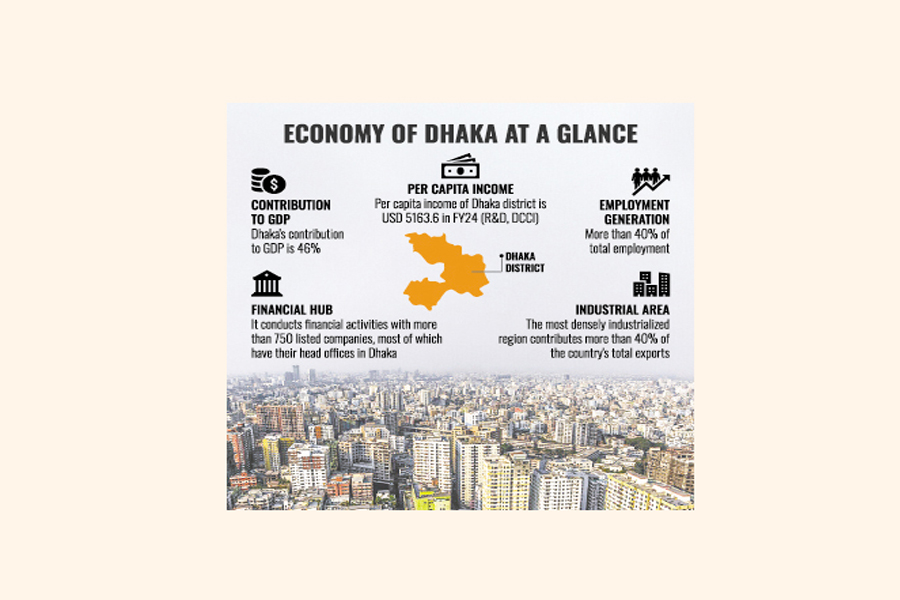
Published :
Updated :

Dhaka district that hosts Bangladesh's centrepetal capital city alone accounts for nearly 46 per cent of the national GDP, estimated at US$462 billion in FY2024-25, while the Dhaka-dwellers enjoy nearly double the country's per-capita income.
Such over-concentration of the economy and fortune in and around the capital comes clear in a new economic analysis by Dhaka Chamber of Commerce and Industry (DCCI), in a stark contrast in comparison with the countryside, as shown by central bankers.
The study reveals that per-capita income in Dhaka stands at $5,164 - nearly twice the national average of $2,820 - while it remains the largest employment hub, generating over 40 per cent of total jobs.
The findings were unveiled Saturday at a focus-group discussion arranged by the DCCI on its newly developed Economic Position Index (EPI), chaired by its President Taskeen Ahmed.
Dr AKM Asaduzzaman Patwary, Acting Secretary -General of the DCCI, presented the keynote, which reveals the EPI for October-December 2024 stood at 0.80 in the "high -change" range, reflecting a rebound in economic activity after a near-shutdown in July-September, immediate after the mass uprising leading to political regime change.
Representatives from the government, Bangladesh Bank, academia, research institutions, and the private sector spoke at the event.
In his welcome remarks, Taskeen Ahmed said that several local and international indices track the country's business environment, fail to fully capture the real dynamics and drivers of economic activity.
To address this gap, DCCI has launched the EPI, initially covering Dhaka city, with plans to expand it nationwide over time.
He added that the quarterly index would offer detailed insights into production, sales, order flows, exports, employment, business confidence, and investment trends, drawing data from sectors that include ready-made garments, textiles, wholesale and retail trade, real estate, transportation and storage, and banking.
Presenting the keynote, Dr Asaduzzaman Patwary said the services-sector EPI for the last quarter of 2024 stood at 0.82 on a scale of 0 to 1, where 0 indicates no change and 1 reflects a massive shift in production outputs.
The manufacturing-sector EPI was also recorded at 0.82, while the combined EPI, calculated using the geometric mean of the two sectors, stood at 0.80.
He said that the study was conducted during February-March this year, involving interviews with a total of 654 respondents- 365 from the manufacturing sector and 289 from the services sector.
The study shows the manufacturing sector contributes 56 per cent and the services sector 44 per cent to the economy of Dhaka.
He said the EPI could provide "a quantifiable policy tool" for government use in tariff, fiscal, and industrial-policy adjustment. "Full benefits of the index will be realised if policymakers use it to understand sectoral shifts and policy impacts."
Former DCCI president Abul Kasem Khan said the ready-made garment sector enjoys more benefits, making direct comparisons with other sectors less meaningful.
He notes that SMEs, while a major source of employment and a key driver of the economy, have not developed as expected.
Commenting on the newly developed index, he urged that data analysis should extend beyond internal assessments to include comparisons with competitor countries.
The keynote warns that Bangladesh lags behind on most economic indicators due to delays in evaluating and implementing reforms, and calls for digitising city corporation trade licence issuance to cut time and reduce red tape.
Miah Rahmat Ali, Senior Private-Sector Specialist at the IFC, said the EPI is only the second homegrown economic index in Bangladesh and welcomed the government's move to introduce an Insolvency Act to ease business processes.
Md Nurul Alam, Director -General at the National Productivity Organisation (NPO), said information on change in the pulse of the economy would help incorporate proper policy.
He stressed the need for more careful data collection in research activities, which would help in better policy formulation, and also highlighted the importance of identifying how industrial services affect productivity.
Dr Md Salim Al Mamun, Director, Bangladesh Bank, noted that while Dhaka's per -capita income is double the national average, the district's poverty rate 19.6 per cent still exceeds the national average 19.2 per cent.
"The concentration of people in Dhaka drives both higher income and higher poverty," he said about a paradox, urging inclusion of agricultural and rural data in future research.
Nawshad Mustafa, another Director of the central bank, said SME policies have already been simplified, but sharing data on loan-access barriers could help the central bank take more targeted actions.
Md Nurul Alam, Director -General of the National Productivity Organisation (NPO), highlighted that understanding shifts in the "pulse" of the economy can guide more effective policy.
jahid.rn@gmail.com


 For all latest news, follow The Financial Express Google News channel.
For all latest news, follow The Financial Express Google News channel.